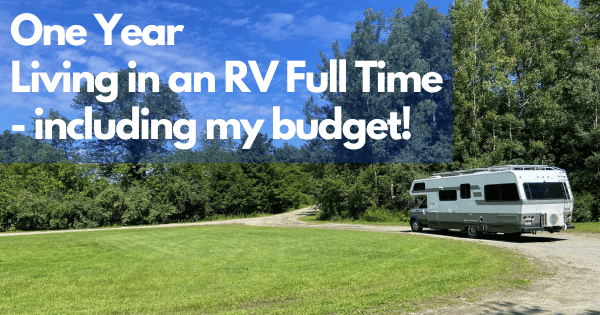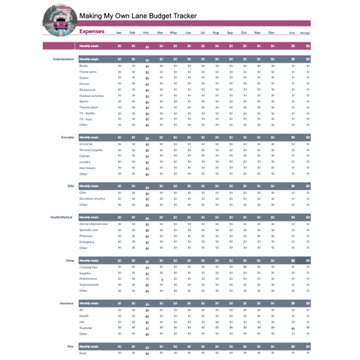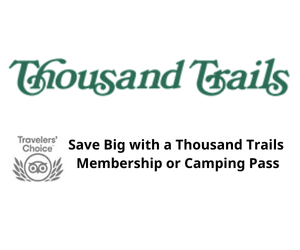One Year Living in an RV Full Time as a Solo Female RVer - How Much Did It Cost?

One Year Living in an RV Full Time as a Solo Female RVer How Much Did it Cost?
Written by Nancy Carter, Making My Own Lane
There has definitely been a learning curve in my one year of living in an RV, whether you are a solo female RVer like me, or traveling with a partner!
Some of it I spoke about in my blog post 8 months of full-time RV living.
What I have learned in one year living in an RV.
Because I am going to share my budget with you as well, I will talk about what I learned as it relates to trying to keep my budget down so I can travel and live in my RV as long as possible.
I’ve divided it into 10 categories.
Gas and Traveling in an RV.
Lesson: Obviously, the more you travel, the more money you will spend on gas.
This year I have chosen to spend half of my year in Florida, and I traveled the other 6 months.
Not only did this keep my RV gas costs down (I have only spent $650 on gas for the RV in the past 6 months compared to $3,000 for the six months I was traveling), but it allowed me to slow down, earn some money, spend time with my family that lives in Florida, and form relationships with many new friends within the campgrounds I have stayed in.
When I created my budget for my first year, based on nothing but research and guesstimates, I allowed $3600 total for gas. The total I spent for both diesel for my Class C RV and my Jeep was $3129.
RV Repairs and Maintenance.
I allowed $2400 for RV repairs and maintenance. I actually spent $2800. $3,077 if you add in the rental car I got when I needed a repair in Maine.
But, this was more because of regular RV maintenance, like resealing the RV, oil changes, air filters changes, inspecting the mini split AC/heating unit and changing wiper blades, than it was for unexpected repairs, like brakes.
These are going to be things that I will have to do on a yearly basis, so I have upped my RV repairs and maintenance budget to $3,000.
Lesson: It is so important to have some emergency funds put aside in case you do need a larger repair, or new tires, or both. Or if you need to rent a car or stay in a hotel for a few nights.
RV Utility Costs.
Including phone/internet/propane/water.
I allowed $300 a month for this, and I actually spent $236 a month.
The biggest reason for this was the internet. And while my internet situation is not perfect (I don’t know if anyone is), it worked well enough for me.
There were times I had to go to Starbucks for internet, or sit in a parking lot that had better reception than my campground, but I was able to make it work.
I wasn’t sure if I was going to have to “upgrade” to another provider, and I still may have to make some changes this year that will probably put me over the $300 budget.
Lesson: you have to be flexible and adaptable. I’m still working on this. Especially now that I have been writing this blog weekly. I may not be able to be as consistent with a weekly blog once I start to travel again next month.
Spending money on water was something that surprised me, as I primarily stay in campgrounds with water hookups on a regular basis and I have a water filtration system in the RV.
However, sometimes that water at the campground was either shut off for repair, or under a boil water alert. It happens more than I thought it would.
In total, I spent $76 on water for those times when I only felt comfortable using bottled water.
I learned to carry about 5 gallons of water for drinking and I usually drive with my onboard fresh water tank about ⅓ full, so I can do dishes or take a shower.
Propane $108. I use propane to heat my hot water tank and to cook.
Once in a while I would use it to heat the RV for a few minutes in the morning on those very cold days; however, I have a small, electric heater, as well as the heater on my mini split that I use most of the time. And a few warm homemade quilts!
Groceries and Supplies.
I budgeted $200 a month for groceries. It’s just me. I do eat a lot at home, and freeze leftovers to eat on travel days. I also started out with a lot of food from my sticks and bricks house, like meat that I canned.
I actually spent $213 a month, or $2560 on groceries. Pretty close.
Going into year two, I think I will have to up the budget. One reason is because I have made my way through the food I started out with, and two is because the price of food continues to rise every month.
Restaurants and Activities.
Last year I spent about $800 on activities. Boat rides, horse and carriage rides, guided walking tours, and visiting local attractions and places of interest.
Add in $750 for Florida theme park passes.
And another $739 for Amazon Prime, Netflix and Kindle.
Throw in another $2,500 for restaurants, and that’s $4,789 total, or $399 a month. My original allowance was $400 a month, so I am right on budget.
Lesson: As you travel, you will be able to find things to do that don’t cost that much, or are even free. That cost will be offset by things that you want to do that charge admission.
Another reason for me to travel six to eight months and stay in one place for four to six months.
When you travel, of course, you will want to see different things in the places you stay. And the more you travel, the more exciting things there are to do, and to pay for.
Laundry Costs Living in an RV.
I average about $15 a month in laundry. Most campgrounds charge $5 for wash and dry. Some are less, some are more. And, it was a learning cycle.
Sometimes you can catch the tail end of someone’s dry cycle and add another dollar for more time instead of starting all over again at $3.00.
By speaking to people in the campground and laundry rooms, you will learn little tricks, and meet new people.
Lesson: I’ve also taken advantage of washing EVERYTHING if I am house sitting or pet sitting for a friend or family member.
And, I do have a small wash and spin washer that fits in my dryer that I use for smaller items, like lingerie or yoga pants and shorts. Those are the items I wear the most and run out of first. Overall, it has probably cut my laundry costs in half.
It may only save me $200 a year; however, that is more money I have to spend on cool activities.
RV Camping Fees.
Because I am a Thousand Trails member, I can camp for less than $5 a night in over 200 campgrounds across the country. You can read more about the Thousand Trails program here.
But, sometimes there are not Thousand Trails campgrounds where I want to go, or I want to stay in a specific campground, and I do pay for these.
In my first year of living and traveling in my RV, I was able to use Thousand Trails campgrounds for 298 nights out of 365, and my total cost for camping was $2592, or $216 a month.
I already know that this year I will be spending about 90 days outside of the Thousand Trails system, and I expect my campground charges will be 30 to 40% more because I won't be spending as much time on the property of family and friends as much. And I've booked a couple of expensive campsites.
Lesson: To save money, use my Thousand Trails membership and moochdocking (spending time on the property of family and friends) wherever I can.
But, I bought an RV to travel and see the US, and travel and adventure costs money.
Get out and camp! Let me help you get the best deal on a Thousand Trails Camping Pass or Membership.
RV and Car Insurance.
This is a double-lesson item.
I have full-time RV insurance on my RV. Not all companies sell full-time RV insurance in every state. While you don’t need full-time insurance if you own a home because your homeowners would cover the contents of the RV, I no longer own a home. So it was important to me to have good coverage here. I currently pay $1,344 a year for this type of insurance.
In December, I added a car to our traveling family. Car insurance in Florida (my domicile state) is a little crazy, and I pay $1,472 a year, with an excellent driving record.
In April, I added a tow dolly to tow the jeep. I didn’t count the car and the tow dolly in my expenses.
When you first start your RV life, you really don’t know what you will need, including whether your first RV is the perfect one for you.
I found that spending time in one area over the winter, it was much easier and less expensive to have a separate car to get around rather than to have to take my Class C RV with me everywhere, or Uber.
When I first bought the Jeep, I used Uber to get my vehicle from one campground to another, which I quickly grew tired of. That’s why I added the tow dolly.
Lesson: As a solo RVer, some things, like pushing a tow dolly around or carrying heavy or bulky items, require a bit more strength that I thought I would be using. Make sure you can physically handle items you buy before you buy them, and take the time to know how to use these items before you actually need to use them. But that’s another blog story.
If you decide to sell it all and go full-time, you will have to decide where your domicile state is, or where you will receive your mail. Even with the higher cost of car insurance, Florida is the best place for me at this time (Hint - there is no state income tax in Florida).
The total for full-time RV insurance and car insurance is $2,816 a year, $235 a month. I would love to be able to bundle my RV and car with the same company; however, it is less expensive for me to use two separate companies right now.
Lesson: Do your research on the best domicile state for you.
Pets.
Not everyone has pets; however, I have found that a lot of people that travel have at least one pet.
I have 2 dogs and a cat. The cost for food, vet visits,medications and grooming for my crew came to $2,456, or $205 a month, compared to the $200 I originally budgeted.
Other RV Living Expenses.
There are other things that you will need and/or have $ allocated in an emergency fund. These include health insurance and health care and dental care, gifts, life insurance.
How my costs compared to what I budgeted for my first year of RV living - Summary.
1. Gas and Travel.
What I budgeted $3,600
What I actually spent $3,129
2. RV Repairs and Maintenance.
What I budgeted $2,400
What I actually spent $3,077
3. Utility Costs.
What I budgeted $3,600
What I actually spent $3,200
4. Groceries and Supplies.
What I budgeted $2,400
What I actually spent $2,560
5. Restaurants and Activities.
What I budgeted $4,800
What I actually spent $4,789
6. Laundry Costs
What I budgeted $300
What I actually spent $184
7. Camping Fees.
What I budgeted $5,544
What I actually spent $2,592
8. RV and Car Insurance.
What I budgeted $1,344
What I actually spent $2,080
9. Pets.
What I budgeted $2,400
What I actually spent $2,456
The total I spent in my first year of living in an RV full time.
What I budgeted $26,388
What I actually spent $24,067
What I learned in my first year about the cost of living in an RV full time.
Living and traveling in an RV is less expensive than living in a house, for me.
Compared to living with a mortgage, homeowner’s insurance, repairs and maintenance on a house, utility bills that included electricity and water, and gas to drive 30 minutes a day to and from work, I definitely spent less.
And I was able to travel six or seven months last year, compared to two or three weeks in my old life.
I don’t feel I spent less on activities and eating out. In fact, I probably spent more, because there was more available for me to do!
My stress level is down, I feel happier, and I get to spend more time with my family, friends (old and new), and my pets.
I feel more in control of my finances, and my life.
Because I keep track of my spending, I can see where I can cut back if I need to.
Working from the road is still a work in progress, but I’m figuring it out. And I have so many options I haven’t even explored yet.
Check out What is the True Cost of RV Living? here.

If you have any comments, suggestions or questions about what I learned or what I spent in my first year of RV living, you can message me here.
Thanks for joining me as I move into Year 2 of this full-time RV life.
Subscribe below for updates as we travel and continue to learn more about life on the road.
Thank you for subscribing!
Have a great day!

Hi there! I'm Nancy.
In 2023, I ditched my heels for hiking boots, sold my house, and decided to travel the US full time in my 2005 Lazy Daze Class C RV.
I love to share the places I travel to and what it's like to live in an RV full-time.
If you have ever thought about hitting the road and traveling in an RV, either in your free time or full time, you are in the right place!
Follow along for weekly blog posts about my adventures as I travel the US with my two dogs, Rufus and Willie, and my cat, Katie.
